Lenses you can use with a Nikon d5600 camera.
Lenses are not just an accessory for your camera, but a device that can enhance your camera performance if you choose it correctly. The lens type depends on the purpose of use. We’d like to take a look at different Nikon D5600 lenses so that you can decide which one suits your needs.
We introduce a large selection of decent and affordable lenses for you to choose the best lens for Nikon D5600. You will find all the detailed information about the models, their performance, and functionality.
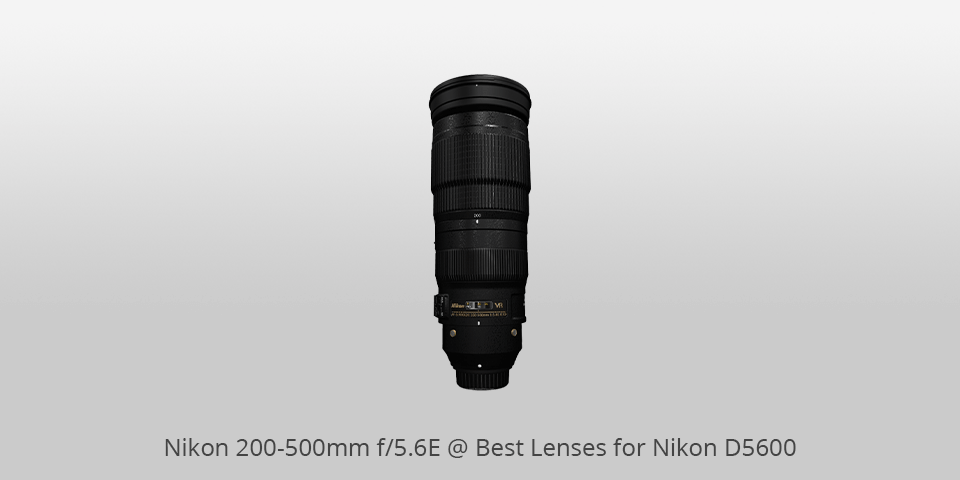
Mount: F | Diaphragm blades: 9 | Autofocus: yes| Min focus distance: 2.2 m | Max magnification: 0.22x | Filter thread: 95 mm | Dimensions (WxL): 108 x 267.5 mm | Weight: 5.07 pounds
⊕ Sharpness
⊕ Long telephoto coverage
⊕ Fixed f/5.6 aperture
⊕ Well-stabilized image
⊖ Weaker compared to analogs
⊖ Soft edges at 200mm
⊖ Doesn’t work for older D-SLRs
A decent lens that perfectly complements the NIKKOR series of lenses. Despite its f/5.6 aperture, which is questionable for professional sports photographers, its moderate price and excellent VR make up for all doubts and will not go unnoticed. It is also good for shooting in the wild, and therefore we recommend wildlife photographers paying attention to this option.
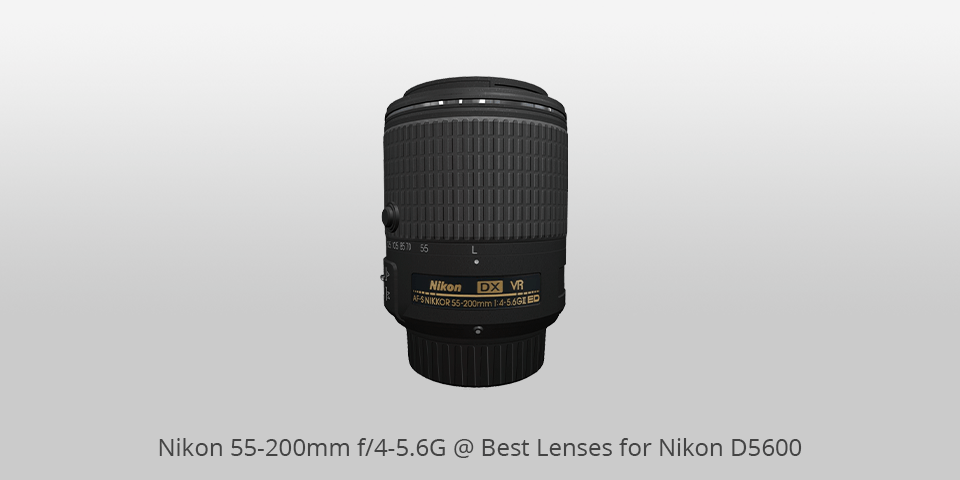
Mount: F | Diaphragm blades: 7 | Autofocus: yes | Min focus distance: 1.1m | Max magnification: 0.23x | Filter thread: 52mm | Dimensions (WxL): 73*100 | Weight: 335g
⊕ IS system
⊕ Integrated autofocus
⊕ Comes with hood
⊕ Inner focusing
⊖ Aperture is a bit slow at the wide end
⊖ Variable aperture
⊖ Poor Aperture at Tele end
Compact and foldable lenses are not only convenient but also popular these days, because few people want to carry a huge bag with a bunch of removable lenses.
The Nikon 55-200mm f/4-5.6G boasts absolute Nikon D5600 lens compatibility and is a fairly good device that offers entry-level optics functionality. For it to be truly valuable to a buyer, the price has to come down slightly, as the lens is now £100 more expensive than its non-collapsible analogs.

Mount: F | Diaphragm blades: 7 | Autofocus: yes | Min focus distance: 45 cm | Max magnification: 0.23x | Filter thread: 67mm | Dimensions (WxL): 78 x 97 mm | Weight: 490 g
⊕ Highly sharp
⊕ 7.8x zoom range
⊕ Well-stabilized optics
⊕ Rather compact
⊖ Causes distortion
⊖ Poor edge performance
⊖ Comes without hood
Unlike its predecessor, the Nikon AF-S DX Nikkor 18-140mm f/3.5-5.6G ED VR extends the zoom range, while offering slightly more distortion and less sharpness at maximum aperture. Sharpness can be improved by lowering the aperture when shooting, and distortion can be fixed in the camera settings or during editing. Whether you are willing to pay extra $100 + for more coverage is up to you, but after examining the lens, we rate it lower than 18-105mm. We recommend looking at the analog Sigma 17-70mm model, which offers a wider aperture and close focusing for the same price.
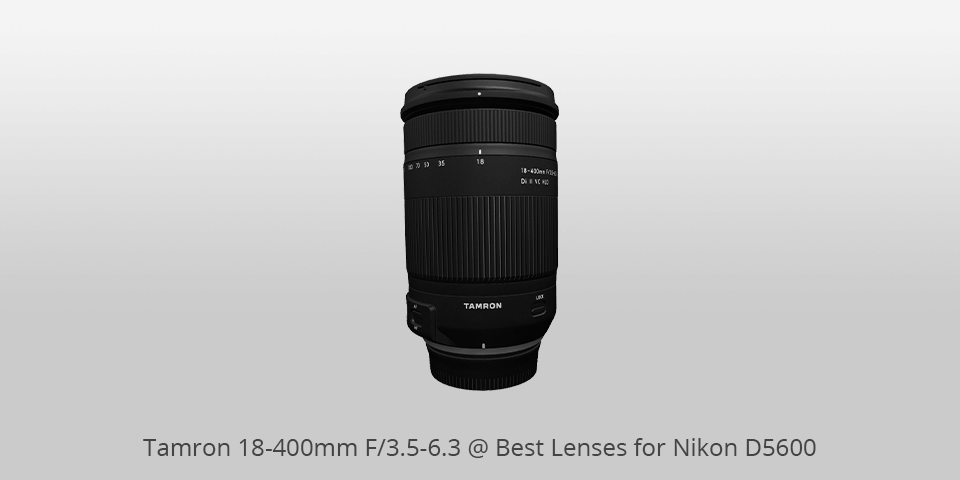
Mount: EF | Diaphragm blades: 7 | Autofocus: yes | Min focus distance: 45 cm | Max magnification: 0.34x | Filter thread: 72mm | Dimensions (WxL): 79 x 123.9 mm | Weight: 710 g
⊕ 22.2x zoom rate
⊕ High image quality
⊕ Optical stabilization
⊖ Wide-open performance is poor beyond 300mm
⊖ Slight chromatic aberration at longer focal distances
⊖ Noticeable distortion
If you are looking for a superzoom, then the Tamron 18-400mm f/3.5-6.3 Di II VC HLD is the one for you. This is the best lens for Nikon D5600 in terms of magnifying capacity, affordability, and compactness. Like many lenses, this model has its drawbacks, such as a narrow maximum aperture, slight distortion, and poor picture quality at the edges and the long end of the zoom range if you don't narrow the aperture. Still, unlike the $579 Sigma 18-300mm Contemporary ($309.99 on Amazon), the $650 Tamron 18-400mm f / 3.5-6.3 Di II VC HLD covers a larger zoom range.
The only similar lens Canon has to offer as an alternative to the Tamron 18-400mm f/3.5-6.3 Di II VC HLD is the $699.99 EF-S 18-200mm. Nikon has a couple of 18-300mm counterparts like the $1000 Nikkor DX 18-300mm f / 3.5-5.6G ED VR – a durable and expensive lens. Plus, the $700 DX Nikkor 18-300mm f / 3.5-6.3G ED is costly and poor in performance. If you own a Nikon camera and can afford to pay a little more, we recommend considering the 18-300mm f/3.5-5.6G ED VR model.

Mount: EF | Diaphragm blades: 9 | Autofocus: yes | Min focus distance: 27.69 cm | Max magnification: 0.14x | Filter thread: mm | Dimensions (WxL): 90.7 x 129.8 mm | Weight: 950 g
⊕ Remarkably sharp
⊕ Unnoticeable distortion
⊕ Min focus distance is short
⊕ Supports various systems
⊖ Heavyweight
⊖ Dark corners and edges
⊖ With no filters support
Generally, wide-angle lenses are usually large and rarely come with f/1.4 apertures. Despite full Nikon D5600 lens compatibility, the Sigma 20mm F1.4 DG HSM Art minimizes barrel distortion, captures a lot of light, focuses at close range, and offers excellent image detail. Given its size and weight, you can imagine how much glass is required for all this. Like many wide-angle lenses, this one delivers dim corners and edges, but you can fix the problem with the software.
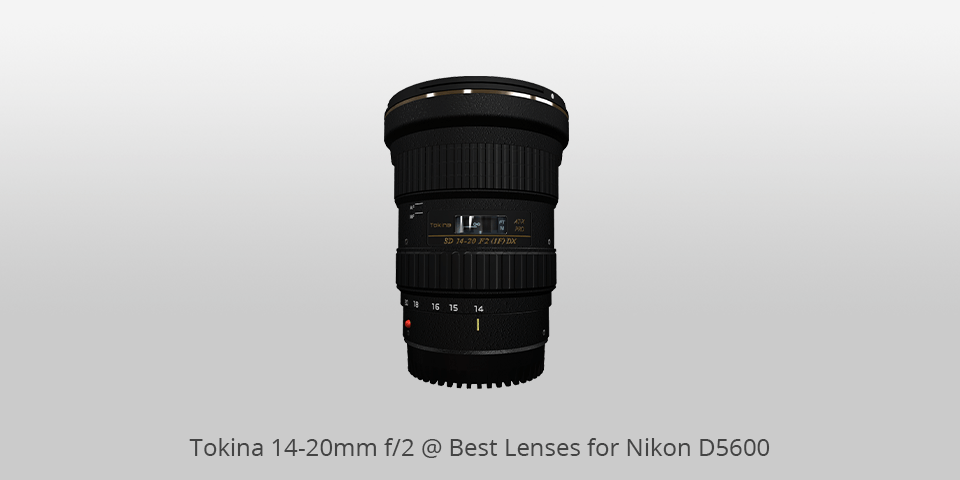
Mount: F | Diaphragm blades: 9 | Autofocus: yes | Min focus distance: - | Max magnification: 0.12x | Filter thread: 82mm | Dimensions (WxL): 89 x 106 mm | Weight:725 g
⊕ Suitable for APS-C 4K videography
⊕ High-level sharpness
⊕ Brightness
⊖ No integrated picture stabilization mechanism
The Tokina 14-20 mm f/2 stands out among analogs with its brightness. The sharpness is similar to other models in this series, but it knocks them out at f/2. The Tokina 14-20 mm f/2, along with the Sigma 18-35 mm f/1.8 Art (which starts at focusing distances where Tokina stops), are among the world record holders in terms of wide-angle lens brightness. It offers zooms for cameras with an APS-C sensor. Like the less bright wide-angle zooms on cameras with a full-frame sensor, the Tokina 14-2 mm f/2 with APS-C sensors also offers beautiful bokeh. This model works great for high-quality photo and video shootings.
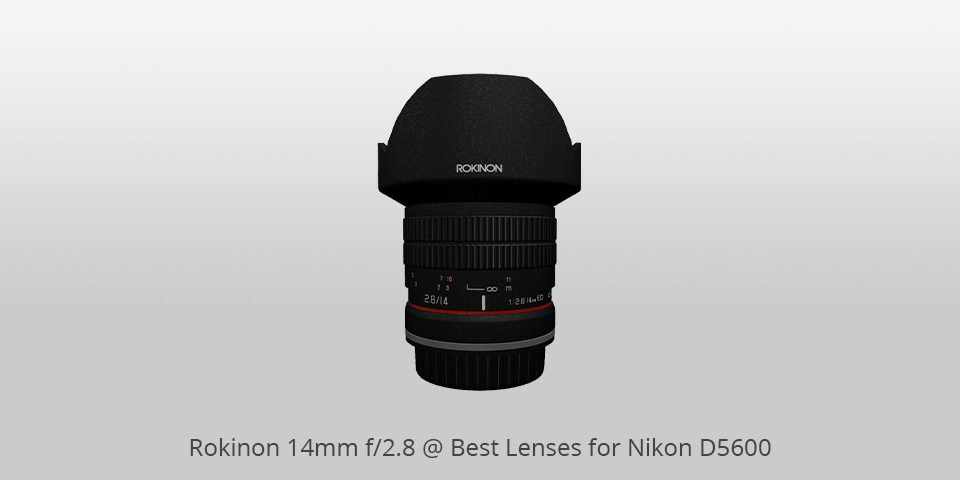
Mount: EF | Diaphragm blades: - | Autofocus: no | Min focus distance: 27.43 cm | Max magnification: x | Filter thread: mm | Dimensions (WxL): 87.12 x 96.01 mm | Weight: 550 g
⊕ Portable construction
⊕ Ultra-wide viewing angles
⊕ Strong metal barrel
⊕ Built-in lens hood
⊖ Poor autofocus
⊖ Sharpness issues at f/2.8
The AF 14mm f/2.8 lens is the first Rokinon/Samyang autofocus lens for Nikon. This device quickly took first place on my list of 14mm favorites.
Even if 14mm is not a priority, this lens is small and lightweight, making it easy to fit in a bag or backpack. Besides, the AF 14mm f/2.8 lens has a beautiful design. Its reasonable price, combined with a high-quality image, attracts buyers and encourages them to make a purchase.

Mount: EF | Diaphragm blades: | Autofocus: no | Min focus distance: 28 cm | Max magnification: x | Filter thread: mm | Dimensions (WxL): 87.12 x 96.01 mm | Weight: 550 g
⊕ Low-cost
⊕ Great sharpness in the center at f/2.8
⊕ Strong build quality
⊕ Lightweight and compact
⊖ Causes wavy distortion
⊖ Makes the shot dim towards the edges
⊖ Without hyperfocal scale or hard infinity stop
The Samyang 14mm F2.8 is a basic lens that may not be suitable for all users, but those looking for an ultra-wide-angle device with high image quality will be pleased with this 14mm performer.
This Nikon D5600 action lens offers excellent sharpness even at maximum aperture, and edge quality is great at f/5.6 or beyond. Professional photographers can notice slight distortion and dim corners, but if you're on a tight budget, I recommend looking at this model. You will be satisfied with the image quality for such a low price.

Mount: F | Diaphragm blades: 9 | Autofocus: yes | Min focus distance: 28cm | Max magnification: 0.15x | Filter thread: - | Dimensions (WxL): 98 x 131.5 mm | Weight:1000 g
⊕ High sharpness
⊕ Ultra-wide field of view
⊕ Full-frame coverage with f/2.8 aperture
⊖ Visible wide-angle distortion
⊖ Needs a particular holder for filters
⊖ Large
⊖ High-priced
Those who love the ultra-wide perspective will appreciate the Nikon AF-S Nikkor 14-24mm f/2.8G ED. This low light lens Nikon model has its drawbacks like distortion at its wide ends, as well as the lack of a filter holder that entails additional expenses (especially if you're using gradual ND, polarizing, or similar optical filters). Though the Nikon AF-S Nikkor 14-24mm f/2.8G ED is not a device for daily use, if you decide to purchase the one, you will be satisfied with the quality of your shooting.
| Image | Name | Features | |
|---|---|---|---|
 |
Nikon 200-500mm f/5.6E
Our Choice |
CHECK PRICE → | |
 |
Nikon 55-200mm f/4-5.6G
Budget |
CHECK PRICE → | |
 |
Nikon 18-140mm f/3.5-5.6G
Zoom |
CHECK PRICE → |

Before choosing a lens for DSLR photography, you need to decide on your goals and style. You will face difficulties when choosing, especially if this is your first time, but we will help you figure out which lens type to opt for – wide-angle, zoom, prime, or fixed aperture lens.
One type of Nikon D5600 lenses is a zoom lens that allows for bringing your subjects closer. These lenses help you create perfect compositions by zooming in or out. Most users choose Nikon D5600 zoom lens because of this possibility.
Unlike zoom lenses, the primes aren’t capable of zooming in. You only have one focal length available. Nikon D5600 Prime lenses have a smaller aperture, and some have up to f1.2. It means that this low light lens Nikon model allows transmitting more light and performs well in low light conditions.
If the lens has built-in image stabilization, you can shoot at slower shutter speeds without motion blur. On the one hand, this is a very useful option for certain types of photography, but on the other hand, it may not come in handy and become a waste of money. In case you are shooting fast-moving objects, you don’t need the image stabilization function, just like if you use a tripod.
When choosing Nikon D5600 lenses, pay attention to the aperture index. The larger the aperture, the less light it lets in. Accordingly, the smaller the aperture, the more light enters the camera.
To choose the best lens for Nikon D5600, you need to consider focal lengths. If you love wildlife, sports, or nightlife photography, a lens wider than 50mm is your sure choice.
Generally, landscape photography requires wide-angle lenses for the Nikon D5600. Besides, wide-angle lenses are well-suited for nightlife photography where you have limited space. These lenses deliver high image quality.
A medium-range occupies the middle position, which is where the name comes from. It cannot be too long or too close. The mid-range lenses are suitable for portraiture, wedding photography, and studio photography with models.
If you are looking for a lens for nature, sports, or glamour photography, we recommend looking at the telephoto lens. Such products are typically expensive, but when it comes to photography, many accessories are not cheap.

You don't need to worry when choosing a lens for Nikon D5600. Select it wisely and think about the purpose for which you need a lens. Is this portrait or nature photography? Possibly close-ups or sports events. Good preparation will help you make the choice to buy the best lens for Nikon D5600.
If you can afford a fixed aperture lens, I recommend buying the one. Choose the lowest aperture that will brighten your photos, add a blurry background effect, making your photos look like those taken by professional photographers.
The Nikon D5600 is a decent camera that is well worth the money. With 24.2 MP, it takes great pictures. However, if your budget is limited to, let’s say, $700, then I would recommend paying attention to the Pentax K70 as it has a better sensor, higher speed, and lower price. Still, be ready to find a limited number of lenses and accessories for this model.
The Nikon D5600, like its predecessor, delivers 5fps for 12-bit RAW or 4fps for 14-bit RAW, which is great for those who like shooting fast-moving objects like sports, wildlife, or children. The Canon 750D and 760D are only slightly ahead of the Nikon D5600 in speed, offering 5fps for 14-bit RAW.
The Nikon D5600 delivers high enough ISO for a camera of its kind, so you shouldn't have a problem if you use the camera in low light. You can raise the ISO to values in the 1600-6400 range, which will help you get a high shutter speed for your lens and shoot high-quality images.
Rumors about the Nikon D5500 discontinuing have been circulating for a long time. Nikon Japan has confirmed that both their APS-C cameras have been taken off the website. The D5500 and D7200 cameras were released in January and March 2015 and were subsequently replaced by the D5600 and D7500, respectively.

 Rating
Rating